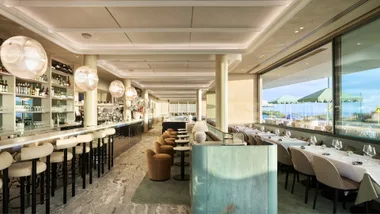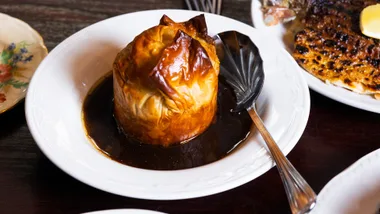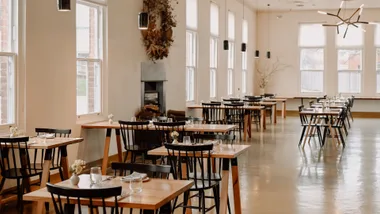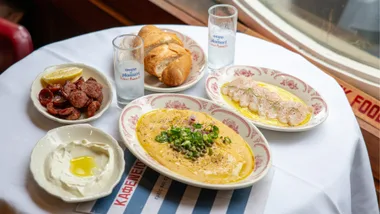IZAKAYA FUJIYAMA
Shop G09, 52 Waterloo St, Surry Hills,
(02) 9698 2797, izakayafujiyama.com.
Licensed.
Cards MC V.
Open Dinner Mon-Sat 6pm-10pm.
Prices Entrées $13-$15; mains $15-$29; desserts $8-$14.
Vegetarian Two entrées, two mains.
Noise Noisy.
Wheelchair access Yes.
Plus Gutsy food with heart. And heads.
Minus Patchy service.
Have the fish head. It’s an unlikely sounding dish, and it certainly conjures images of something Sylvester might pull from a garbage can after another failed attempt at making a meal out of Tweety Pie more readily than images of deliciousness. But boy, is it good.
It’s a sort-of signature for Izakaya Fujiyama, a restaurant that opened in 2011 alongside two others under a new apartment block next to the fabulously bizarre Reader’s Digest building in Surry Hills. What’s an izakaya? Back in Japan, it’s traditionally a drinking house that serves food. In Australia, izakayas tend to be more like eating houses with a focus on boozing, as is the case with Melbourne’s Izakaya Den. Those guys sell fish heads too. It’s a bit of an izakaya thing, and not unlike the bistro tradition of turning slaughterhouse-sweepings into pâtés, terrines and other hearty ballast.
Why would you want to eat a fish’s head? Because once you get past the whole goggling-eyeball, gaping-mouth issue, it presents a wealth of textures and tastes (almost all of them appealing) that you won’t find elsewhere on the fish. Because in carefully splitting, salting and charcoal-grilling the heads, the chefs are working at the acme of their calling – taking something inedible, more or less, and transforming it by means of their art into something desirable. Paul McCartney famously said that one of the reasons he became a vegetarian was he didn’t want to eat anything with a face. The problem, clearly, is that he wasn’t eating enough of the faces themselves.
The faces in this case belong to kingfish, bluefin tuna and salmon. They’re what have been on offer at various times when I’ve pressed the sometimes reticent Fujiyama staff on the matter of “grilled fish head – limited availability”. I’ll concern myself here with the tuna and kingfish because farmed Australian salmon in its cooked state is something I’ll go a long way to avoid. If the tuna’s on, run screaming in its direction. It’s a deeply ugly cut – half the lower section of the jaw rather than the whole head (which I imagine would be a damned impressive sight). It wouldn’t look out of place in a chum bucket or washed up after a particularly gruesome shark attack, but a little patient tinkering with chopsticks in one hand and a robust beer or sake in the other reveals a surprisingly diverse and substantial yield of meat.
The kingfish head is less likely to induce nightmares in under-12s, but still right up there in the satisfaction stakes. There are those who believe that meat cooked on the bone (and indeed under skin) has the finest savour, and this head makes a strong wordless argument in favour of the idea. In both cases, the head is laid out on a board with nothing much in the way of accompaniment, apart from a pile of grated daikon, a ponzu dipping sauce and a cut lemon, all of which I pretty much ignored. It’s quite rich stuff, though, this head-eating business, so you’d do well to order a good helping of the plain, salty asazuke mixed pickles, or the chunky cucumber pickled in sweet ginger and soy.
There goes another shake of the Japanese castanet. It’s an instrument that Hokkaido-born owner-chef Kenji Maenaka lifted from his mum’s house. It calls a waiter to the pass to deliver the plates the chefs have just put up. It’s a groovier take on the usual order-up bell, and its percussion is a link to the rattle in the kitchen at Bodega, the restaurant just a few blocks away where Maenaka worked for the past several years. He’s keen that Izakaya Fujiyama not be tagged the Japanese Bodega. Speaking as a card-carrying Bodega fan, I don’t think that would be such a bad thing, and I think certain comparisons are inescapable, not least because both restaurants are no-bookings places under residential blocks of comparable size in Surry Hills side-streets. They’re also both distinguished by their choice of good-time tunes, by menus best suited to sharing and by kitchen-side bar seating as a complement to tables. The flavours are bold, the prices are fair.
But Izakaya Fujiyama really is its own restaurant, with an increasingly clear identity. The booze on offer is exceptional. Bartender Charlie Ainsbury and sommelier Charles Leong, both people at the peak of their professions, consulted to the restaurant when it first opened in mid-2011, with Ainsbury devising a whip-smart cocktail selection and Leong putting together an ambitiously concise wine list (it was just six labels, but has since been expanded). Sakes have been part of the program from day one, but now that Steve Darazs has joined the team, they’re very much the focus. There are now few local places better to learn more about Japan’s favourite brew, and Darazs has a gift for pushing past the often impenetrable sake terminology, producing apt drops laden with flavours of everything from nutty toast to pickled pineapple. There’s also Sapporo on tap, the excellent owl-labelled Hitachino Nest in bottle in red rice, stout and white ale versions, and rows of single-serve sakes that are perhaps best left as decoration.
Fujiyama is home to Taketoshi Iwama, a criminally underrated sushi chef whose keen blades make neat work of everything from pale, fatty bluefin tuna belly and lightly torched swordfish belly to mackerel and gurnard nigiri of the kind of freshness that only comes from visiting the fish market daily. This being an izakaya, though, there’s plenty on the more robust side of the ledger: a special of pork belly, slow-cooked to tenderness and then rendered crisp on the grill, a lemon cheek and a dab of seriously spicy yuzu kosho, a striking mix of citrus and hot green chilli, cutting its richness. The pork belly on the menu, steamed and then laid on miso-finished hoba (Japanese magnolia) leaves, will err too far on the fatty side for many palates. The big-eye tuna “katsu” strikes the balance between finesse and trencherman delight pretty much bang-on: here, meaty tuna takes the place of the usual pork cutlet in the katsu treatment, neatly and crisply breaded, with gluey daubs of mayo and slices of chilli on the plate for contrast.
I can take or leave a few of the menu set-pieces. The agedashi tofu – deep-fried tofu with braised shiitake mushrooms and okra rather than the usual waving dashi flakes – isn’t the sort of rendition that sets my world on fire. Some diners, too, will be puzzled by the weighting towards gutsy, often fried dishes, and others will be perplexed by the very Japanese takes on three-bean or mashed potato salad. These are izakaya standards, though, true to the easygoing nature of the genre, and well suited to a beer. They’re also outnumbered, regardless, by dishes that have mass appeal. Beef ribs glazed with the sort of sweet soy-based sauce usually deployed in Japanese restaurants on eel and offset with green chilli relish, say, or the superbly beefy grilled skirt steak, or Kenji’s Fried Chicken, a spiced-up take on the kara-age classic.
If you ate at Bodega in the first years it was open, you’ll be familiar with Maenaka’s approach to desserts, right down to the use of the word “Yogo” in the menu descriptions. The Fujiyama Jaffa plays off a pavé of frozen chocolate cake with candied kumquats and their syrup, yoghurt sorbet, “Yogo” choc-custard and – wait for it – rosemary popcorn.
This is food that’s designed to be enjoyed with finger-licking abandon, not frame-by-frame analysis. Which makes the care taken over the dishes by the kitchen, from the sourcing of the ingredients right through to the plating, all the more unusual. In Kenji Maenaka we see the son of a sushi chef, a guy who has worked his way through the likes of Apéritif, the Four in Hand under Brent Savage, and a brief stint at Marque, opening a restaurant that’s both a product of his experience and personality, but also true to the izakaya mould. And that, Sydney, is something we can count as a win.










